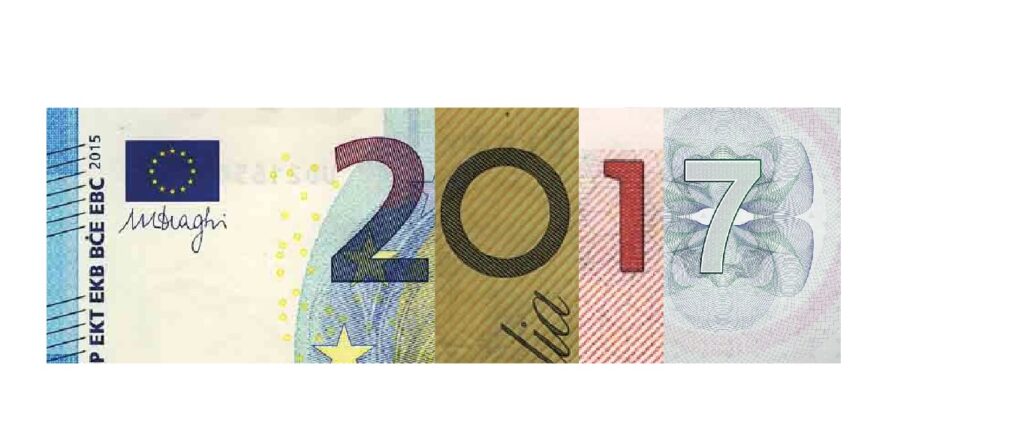Do you wonder what 2017 has in store for you? With 2016 drawing to a close, here are our predictions for 2017 in regard to money and currency.
Tipping point for the cashless society
2017 can well become a tipping point for the cashless economy. Sweden is on track to become the world’s first cashless society. All Swedish krona coins except the 10-krona coin will become invalid in 2017. Banks and shops in Sweden are likely to set limits for accepting coins.Other countries follow suit: In November 2016, India scrapped the two highest valued banknotes, 500 and 1000 Indian rupees. Only 25% of the scrapped banknotes have been replaced so far. The Modi government promotes the use of digital payments. This type of payments are traceable, which means taxes can be levied on them. Smartphone usage in India has exploded, making digital payments available for the majority of people.
The European Central Bank will start phasing out 500 euro banknotes. The Bank of England has stated it has no plans to introduce a new polymer plastic £50 note, meaning the £50 pound notes may be taken out of circulation.
Africa is going cashless as well. M-Pesa is a mobile payment solution used by over 25 Million people in Kenya, Tanzania and South Africa, among other countries. It allows users to use their phone to deposit or withdraw money, pay bills and transfer money to other users.
Contactless payments are now common in many countries, either with a contactless card or a phone. Vendors have started accepting payments via the PayPal app and Bitcoins. With the share of online purchases increasing continuously, it is difficult to imagine a bright future for hard cash.
The end of cheap money
2017 will likely be the end for cheap money: taking out a loan in 2017 will cost you more than it did in 2016. The last half of 2016 saw historically low interest rates. Things have changed since then. Following the Brexit referendum and the election of Trump, most analyst expect a rise in inflation rates, meaning that we’ll pay more for our goods and services.When inflation rates rise, central banks will come under pressure to increase interest rates. Commercial banks will follow suit, resulting in a higher return for savers and a higher cost for loan repayments.
Crackdown on black money: More countries to follow India
In November 2016, India forced its residents to deposit their banknotes of 500 and 1000 rupees in their bank accounts, in order to combat black money. In December 2016, Venezuela followed, forcing all Venezuelans to deposit their 100 bolivar notes.Other world leaders have taken note. It is not unlikely that some of them will follow the example of India and Venezuela, cracking down on black money. Philippines’ president Rodrigo Duterte introduced some controversial measures in 2016. Is it possible that the next set of scrapped notes are the Philippine Peso notes of ₱1000 and ₱500? Or will we see scrapped banknotes in the largest black market economy of the world: the United States?
Safe haven currencies
It is likely that 2017 will be another difficult year for the Euro. With populism and rightwing extremism on the rise in many European countries, currency traders will keep a close eye on the 2017 elections in France, Germany, Italy, the Netherlands and Slovenia. Italian banks may need to be rescued.No one, including the UK government, knows if a deal can be struck in time between the EU-27 and Brexit Britain. The uncertainty is likely to weigh down the value of the Pound Sterling in 2017.
The US dollar is likely to remain strong for a good part of 2017. But the greenback is vulnerable in a scenario where the US returns to protectionism.
Currency traders will make sure to invest a significant part of their portfolio in safe haven currencies. We have identified these five currencies to be the main safe havens for 2017:
A post-Soviet ruble currency union
Most will agree that 2016 was a successful year for Vladimir Putin. It may even be more so in 2017. With Trump in the White House, and allies elected in Europe, there is a good chance that the trade embargo won’t hold.The ruble stabilised in 2016. If the trade embargo gives away, the ruble is likely to plot back to its old levels. It will then be seen over the world as a successful currency. This is a possible catalyst for rekindling the idea of a post-Soviet ruble currency union. The idea was devised already in 2015, but it didn’t happen then because of the fall of the ruble. We may see the birth of a post-Soviet ruble currency union in 2017.

 Loading
Loading